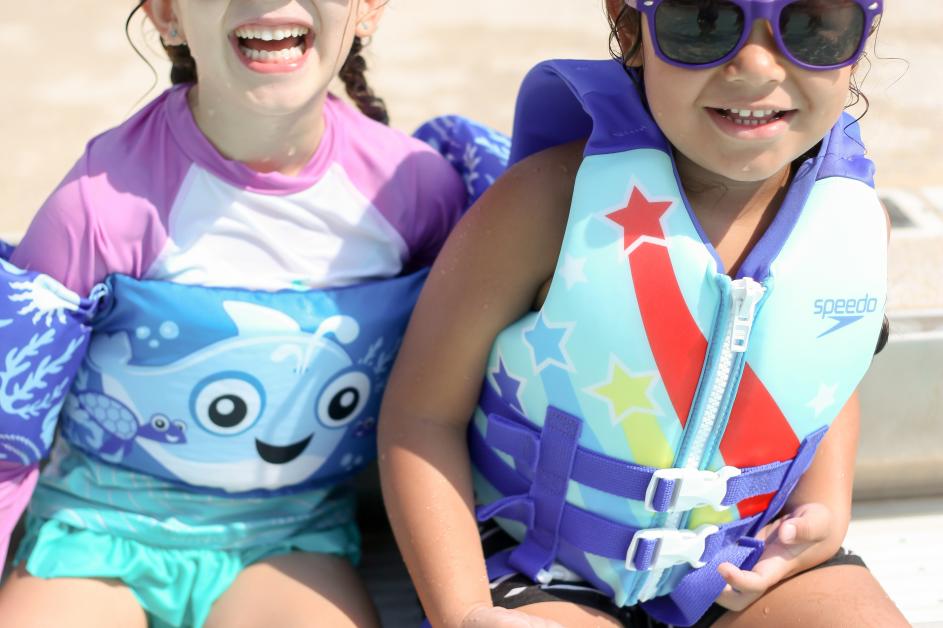
Coast Guard approved lifejackets when appropriately fitted are an important tool in preventing drownings and staying safe in, on, and around water.
Why Wear a Lifejacket?
Barriers and layers of protection are crucial parts in preventing drownings. Lifejackets fall into both of these categories and provide additional protection if there is a lapse in eye-to-eye supervision of swimmers in the water. They are especially beneficial when you and your family are out in open water but can also allow weaker swimmers to gain confidence and some autonomy in a backyard pool while still feeling supported and safe.
Finding the Right Jacket
When choosing a lifejacket for yourself or your child, you want to make sure to find one that is US Coast Guard approved. This means opening up the lifejacket and finding the US Coast Guard approval number on the inside label. Many lifejackets that are not Coast Guard approved are cleverly designed so that from the outside they look similar to Coast Guard approved lifejackets.
The second thing you want to look for on the label is what the “Intended Use” or PFD (Personal Flotation Device) type or level is. You want to choose a lifejacket that is meant for the purpose you are looking to use it for. For example, if you are planning a fun lake getaway with towing activities then you are going to need to find a lifejacket that is rated for boating use, wakeboarding, ski vest, etc. If you are looking for a lifejacket only for backyard or public pool use then one rated as a Flotation Aid or Flotation Device will meet your needs.
Once you have the right jacket for the activity you are going to be doing, you need to make sure to find the right size. Going back to the label on the lifejacket, you will find a recommended weight range and chest circumference. These are the first two pieces of information you want to use to make sure you have the right size lifejacket. The last piece in properly fitting a lifejacket is putting the jacket on, buckling all the buckles, tightening the straps, and checking for a comfortable and snug fit. There should not be extra space around the shoulders or chest area and when you pull upwards on both sides of the lifejacket simultaneously there should be little to no movement. The lifejacket shouldn’t come up towards their chin – if it does, it’s too big. Likewise, lifejackets shouldn’t be difficult to buckle or be so tight they make it hard to breathe. Make sure when fitting the lifejacket both the sides of the lifejacket meet in the center, there should be no gap in-between with a properly fitted lifejacket – if you notice any of these things, it’s too small.
Remember, not all lifejackets are created equal, just like everybody's shape is not the same. This is why fitting your lifejacket to you or your child is so important. Investing this time upfront allows the lifejacket to be fully effective.
Using a Lifejacket
Lifejackets can be an amazing tool and an additional layer of protection when used appropriately. However, it is critical that they add to adult supervision and never replace it. When swimmers are in a lifejacket, the water watcher always needs to be within an arm’s reach of them at all times.
Lifejackets are also not indented replace learn to swim classes. They can help your child gain confidence in the water, but it is important not to over-rely on them as swimming with a lifejacket will not teach your child how to swim independently. Enrolling in regular swimming lessons and at-home practice is crucial explains Jessica Chamberlain, Chandler Aquatics Professional, and mother of two. “My daughter is very confident in the water with her lifejacket on, but when we take it off she is more reserved because she knows that she can’t swim on her own without it yet.” Making regular time to work on swimming skills without a lifejacket and helping your child understand their limitations and swimming ability is a vital step you can take as a parent to keep your child safe around water.
Coast Guard approved lifejackets are a necessary tool in the effort to help reduce and prevent drowning incidents. With the proper type, fit, and use you can keep yourself and your children safe in, on, and around water.
Find more water safety tips and information in the #WaterYouDoing resource hub.



